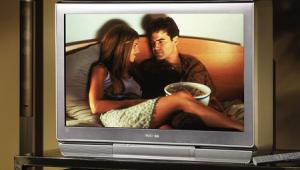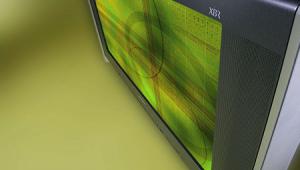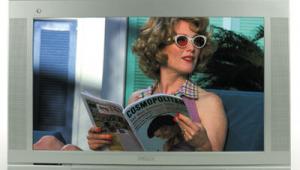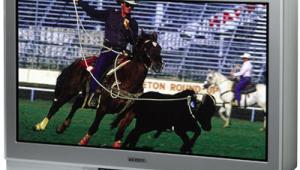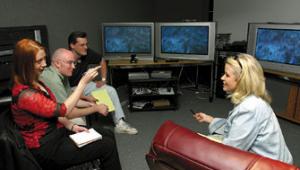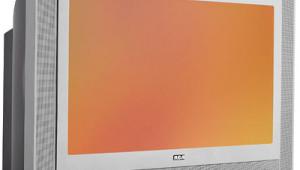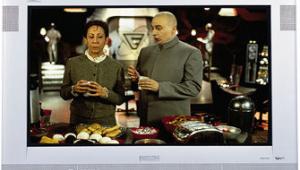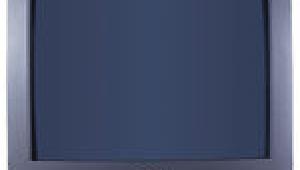Sony KV-36XBR400 Direct-View Television Page 2
One area in which the Sony set falls short of the competition is with black stretch, or the TV's ability to keep brightness levels consistent with rapidly changing black levels. Proton's MM3601VT is more stable than the Sony, although this is admittedly difficult to notice without test signals. On the other hand, the Sony display has a better color decoder than the Proton, although not quite as good as the one in Toshiba's or Princeton's widescreen sets. Test signals indicate that the Sony's decoder pushes red slightly, while green and blue seem accurate. With the color and tint levels adjusted correctly, the set's picture doesn't exaggerate reds as much as I would expect. With regular video, colors seem perfectly natural; there's just a slight hue of pink in European fleshtones. Greens and blues from the Braveheart DVD were thoroughly saturated, offering a bright and vibrant Scottish backdrop.
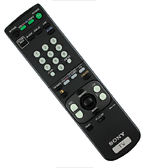 | |
| C. The garden-variety controller has buttons that are easy to find by touch and a large rubber knob that you use to navigate through the menu. |
Composite video sources benefit from the display's awesome comb filter, which removes nearly all of the dot crawl, hanging dots, and cross-color artifacts inherent in the single-cable video format. Of course, using Y/C or component (Y/Pr/Pb) signals from DBS or DVD will yield better results, but at least you can rest assured that your regular video sources—like VHS, laserdisc, and cable—will look as good as possible.
Another benefit is what Sony likes to call digital reality creation (DRC) multifunction. I call it a fancy upconverter. Whatever you call it, the video processor takes regular video's relatively low- resolution (480i) signal and upconverts it to a higher rate (960i). This fills in the scan lines that were horrendously noticeable on the KV-36XBR300, creating a solid, filmlike picture. In addition, the DRC processor looks at both vertical and horizontal detail, which varies by source, and compares it with an onboard database of high-definition signals. The processor then replaces the NTSC image, pixel by pixel, with a matching high-definition image to create a sharper picture.
The results are highly dependent on the source material. DVD, with its high inherent resolution, looks even more detailed with DRC. The image looks extremely similar to native HDTV. The same would likely apply to DBS and a good, clean cable signal. Low-resolution signals, however, like our off-air antenna feed—particularly with its noise and ghosting—don't look quite as good. The DRC seems to add a layer of grain to the image, especially with the more "enhanced" picture settings. A menu adjustment changes the DRC from interlaced to progressive mode so that fine text from devices like WebTV or the Bloomberg stock-quote channel should be more readable.
Comparing the DRC with an external line doubler, such as the DVDO iScan, shows that the DRC does as well as most any other internal line doubler. The DVDO offers better recognition of film sources and therefore eliminates nearly all motion artifacts. Fortunately, the KV-36XBR400 can be used with the DVDO for an even better picture. Unfortunately, the DVDO bypasses the TV's awesome comb filter and automatic anamorphic detection with DVD signals, which we'll get to in a moment. The anamorphic squeeze is still available, even with progressive DVD players—you just have to access it manually from the menu. As it is, the DRC does a fine job of taking good video sources and making them look even better.
By far my favorite feature, however, is the automatic detection of anamorphic DVDs that I mentioned above. Typically, if you have a 4:3 TV, your DVD player will downconvert anamorphically recorded discs so that the image appears on the screen with correct geometry. This results in noticeable motion artifacts and a loss in potential resolution. After all, anamorphic DVDs, when viewed on a 16:9 display, offer 25 percent more resolution than regular DVDs. Fortunately, the Sony KV-36XBR400 continues in the 300's footsteps with a 16:9 mode called vertical compression.
